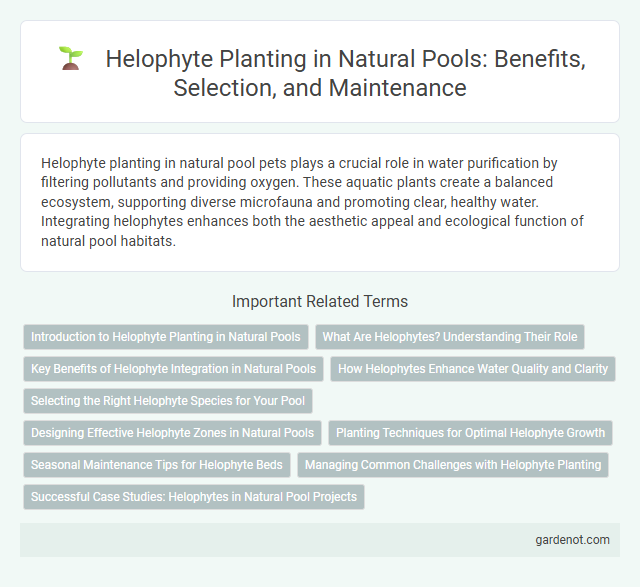Helophyte planting in natural pool pets plays a crucial role in water purification by filtering pollutants and providing oxygen. These aquatic plants create a balanced ecosystem, supporting diverse microfauna and promoting clear, healthy water. Integrating helophytes enhances both the aesthetic appeal and ecological function of natural pool habitats.
Introduction to Helophyte Planting in Natural Pools
Helophyte planting in natural pools involves using marsh plants that thrive in shallow water and wet soil to improve water quality and enhance biodiversity. These plants, including species like cattails, reeds, and sedges, act as natural filters by absorbing nutrients and pollutants, promoting clearer and cleaner water. Integrating helophytes supports ecological balance, reduces algae growth, and provides habitat for aquatic life in sustainable swimming environments.
What Are Helophytes? Understanding Their Role
Helophytes are aquatic plants that thrive in the shallow, saturated zones of natural pools, playing a crucial role in water purification and ecosystem balance. Their extensive root systems absorb nutrients and filter pollutants, preventing algae overgrowth and maintaining water clarity. Incorporating helophyte planting enhances biodiversity by providing habitat for beneficial microorganisms and aquatic wildlife.
Key Benefits of Helophyte Integration in Natural Pools
Helophyte planting in natural pools enhances water purification by promoting the growth of beneficial microorganisms that break down pollutants and excess nutrients, leading to improved water clarity and quality. These plants provide essential habitat and food sources for aquatic wildlife, increasing biodiversity and supporting ecological balance within the pool environment. Furthermore, helophytes contribute to natural filtration and stabilization of pool substrates, reducing erosion and promoting sustainable ecosystem health.
How Helophytes Enhance Water Quality and Clarity
Helophyte planting plays a crucial role in enhancing water quality and clarity in natural pools by effectively filtering pollutants and absorbing excess nutrients such as nitrogen and phosphorus. These emergent aquatic plants promote biofiltration through their extensive root systems, which support beneficial microbial communities that break down organic matter and reduce harmful substances. The combined action of helophytes minimizes algae growth and suspended solids, resulting in clear, balanced, and healthy water ecosystems.
Selecting the Right Helophyte Species for Your Pool
Selecting the right helophyte species for your natural pool is crucial for maintaining clear water and promoting biodiversity. Species such as Phragmites australis, Typha latifolia, and Schoenoplectus lacustris are effective in nutrient uptake and improving water filtration. Consider factors like climate, water depth, and sunlight exposure to ensure optimal growth and ecological balance in your pool.
Designing Effective Helophyte Zones in Natural Pools
Designing effective helophyte zones in natural pools requires selecting native plant species with robust root systems to maximize water filtration and pollutant absorption. Strategic spacing and layering of emergent plants create diverse habitats that enhance biodiversity while optimizing nutrient uptake and oxygenation. Proper helophyte zone placement near shallow margins ensures consistent water flow and supports natural self-cleaning processes in the pool ecosystem.
Planting Techniques for Optimal Helophyte Growth
Helophyte planting in natural pools requires selecting appropriate species based on water depth and nutrient conditions to ensure vigorous growth and effective water filtration. Planting techniques involve using biodegradable pots or planting baskets filled with substrate to stabilize roots and prevent sediment disturbance. Regular monitoring and adjusting intervals between plants optimize space for root expansion and maximize phytoremediation efficiency.
Seasonal Maintenance Tips for Helophyte Beds
Helophyte beds in natural pools require seasonal maintenance to ensure optimal water filtration and biodiversity support. In spring, remove dead foliage and thin out dense clusters to promote healthy growth and prevent stagnation, while late autumn calls for cutting back spent plants to reduce organic debris buildup. Regularly monitoring water levels and nutrient balance helps maintain the ecological function of helophyte zones throughout the year.
Managing Common Challenges with Helophyte Planting
Helophyte planting in natural pools requires careful management to prevent overgrowth and ensure water clarity; regular monitoring and selective thinning help control excessive biomass accumulation. Nutrient imbalances often lead to algal blooms, making nutrient input reduction and substrate management critical for healthy helophyte development. Implementing seasonal harvesting and maintaining biodiversity within planting zones enhances ecosystem stability and supports efficient pollutant filtration.
Successful Case Studies: Helophytes in Natural Pool Projects
Helophyte planting has demonstrated exceptional effectiveness in natural pool projects, as evidenced by successful case studies in Europe where reed and bulrush species significantly enhanced water purification and biodiversity. These plants improve filtration by promoting microbial activity in the root zone, resulting in clearer water with reduced chemical use. Case studies from Germany and Austria highlight how integrating helophytes into the regeneration zone leads to sustainable, low-maintenance ecosystems supporting diverse aquatic life.
Helophyte planting Infographic

 gardenot.com
gardenot.com